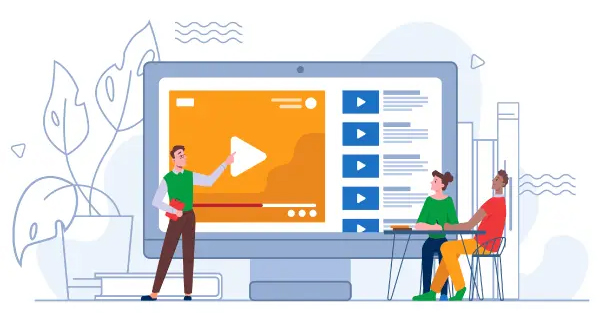
Video lectures are a central component of the online learning experience. But creating effective videos can be time-consuming and challenging. Online video production typically involves writing scripts and learning how to speak comfortably in front of a camera, tasks that differ considerably from delivering lectures to a live classroom. How can course teams help busy instructors develop online video lectures in a way that minimizes the time requirements and plays upon the strengths and preferences of instructors accustomed to teaching in live classrooms?
Here are some of the ideas they discussed during the session.
1. Starting with an Existing Slide Deck
Instructors often have an existing slide deck for material they want to teach online. Using that slide deck as a starting point, review the slides for consistency and flow–chunking them up into the short video segments you will be recording.
Duke’s Heather Hans and Tara Kramling note that you will need to make sure the slides are focused on the online learner. This may require adding clear, learner-focused learning objectives to the beginning of each video segment you will be recording.
Once the slides are organized for the online learning flow, have the instructor deliver the lectures from the slides–just as they would do in a live classroom. Make sure the slides are positioned next to the camera so the instructor can see them while still looking into the camera to address the online audience.
After filming, the slides can be stylized and interspersed with the talking head in post-production editing.
2. Using an Outline vs. a Script
Since online videos need to be focused, succinct, and short, writing out a script can ensure these criteria are met. But some instructors prefer to work from an outline rather than a full script. When creating an outline, Hans and Kramling suggest including at least the main topics–and possibly also the sub-topics. It’s also a good idea for instructors to do a practice run as they finalize the outline before filming.
3. Using the “Late Night Talk Show” Model
Simply recording a lecture in front of a live classroom and using that video in an online course has many drawbacks. Live classroom lectures are much longer than the short videos designed for online learning experiences; and, when delivering a live classroom lecture, the primary audience are the learners in the live classroom, which can make online learners feel like mere bystanders. Effective video lectures need to engage directly with the online learner.
To overcome these pitfalls, John Hart’s team at the University of Illinois has adopted a “late night talk show” model for recording video lectures during regular on-campus lectures. The lecturer speaks directly into a camera with a green screen behind them and lecture slides superimposed. Learners in the live audience watch the lecture on a big video screen, similar to the experience of an audience at a live taping of a late night talk show.
Hart notes that this method is “instructor-centric” in that instructors can go about teaching to a live audience in the way they normally do. This saves time for busy faculty who often have little extra time to create online videos on top of their campus teaching duties.
4. Editing a Live Lecture
Even without adopting the full “late night talk show” model, there are other ways to turn a lecture delivered in a live classroom into short online videos.
Hans and Kramling note that live classroom lectures recorded using Panopto can be chunked into short online videos with some extra work. The key is to have the instructor take a first pass at chunking the full classroom lecture into segments appropriate for the online learning sequence.
The instructional design team can then work with a media producer to fill in gaps, add transitions, and stylize the original slide deck for video presentation. Kramling notes that a good video documentation system is important to help keep track of the content as you cut it down and rearrange it for the online videos.
5. Creating Video Scripts from Lecture Transcripts
Online lecture videos often make use of clearly written scripts to ensure the right content is delivered to online learners in the most efficient and effective way possible. But this doesn’t necessarily mean you always need to start writing from scratch.
The Duke team sometimes starts with the transcript of a live classroom lecture. They then work from the transcript to storyboard or write scripts for the online videos.This approach works well for instructors who prefer speaking their lectures rather than writing them out.
Kramling notes that her team uses Rev, a human transcription service, which provides transcripts of recorded lectures with a one-day turnaround. You might also consider transcription software to help with this process. The transcriptions do not need to be perfect since they merely represent a rough draft that will need to be further organized and revised into online-specific video scripts.
6. There’s No One Size Fits All Approach
Although online lecture videos need to be short, engaging, and tailored specifically to the online audience (e.g., Guo et al. 2014; Brame & Perez 2017), there are many ways to achieve this without letting, as Hart says, “the perfect become the enemy of the good.” Don’t be afraid to explore different approaches as you experiment with finding the techniques that work best for your instructors and course teams.